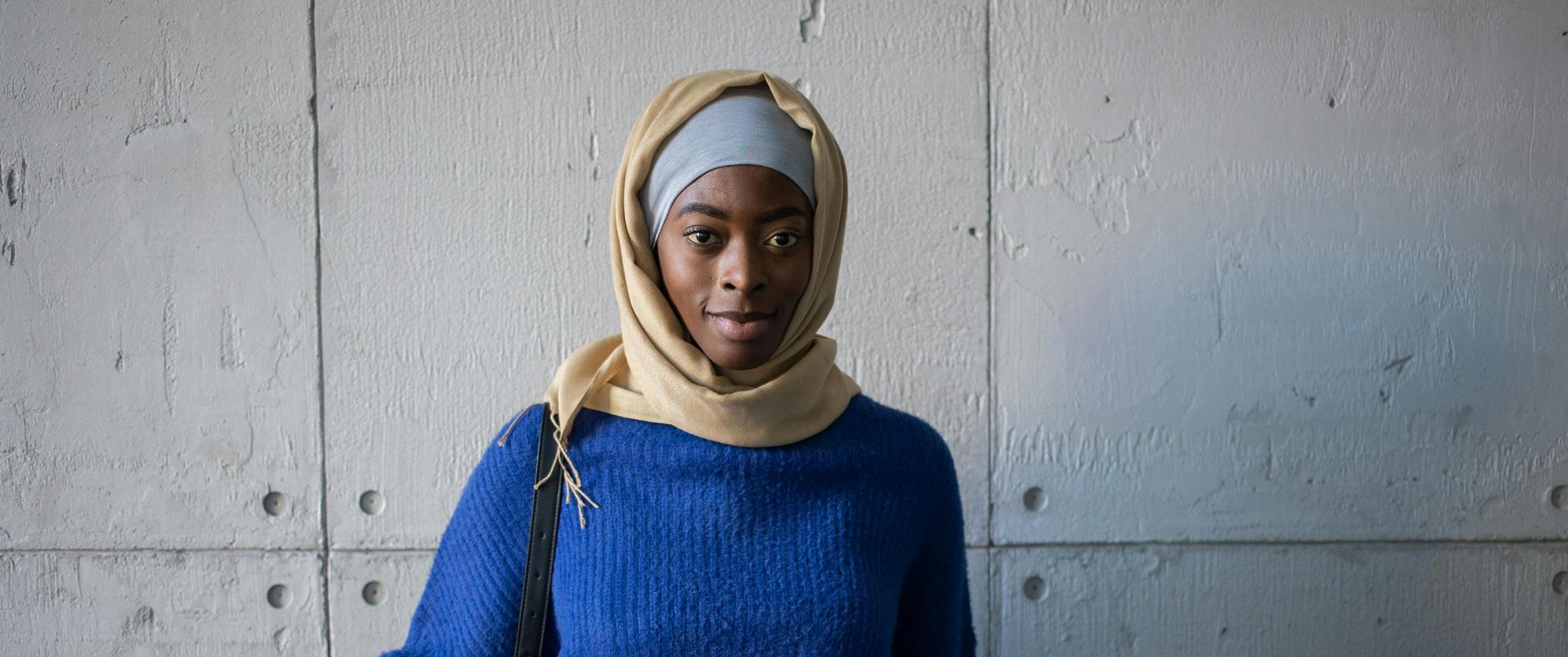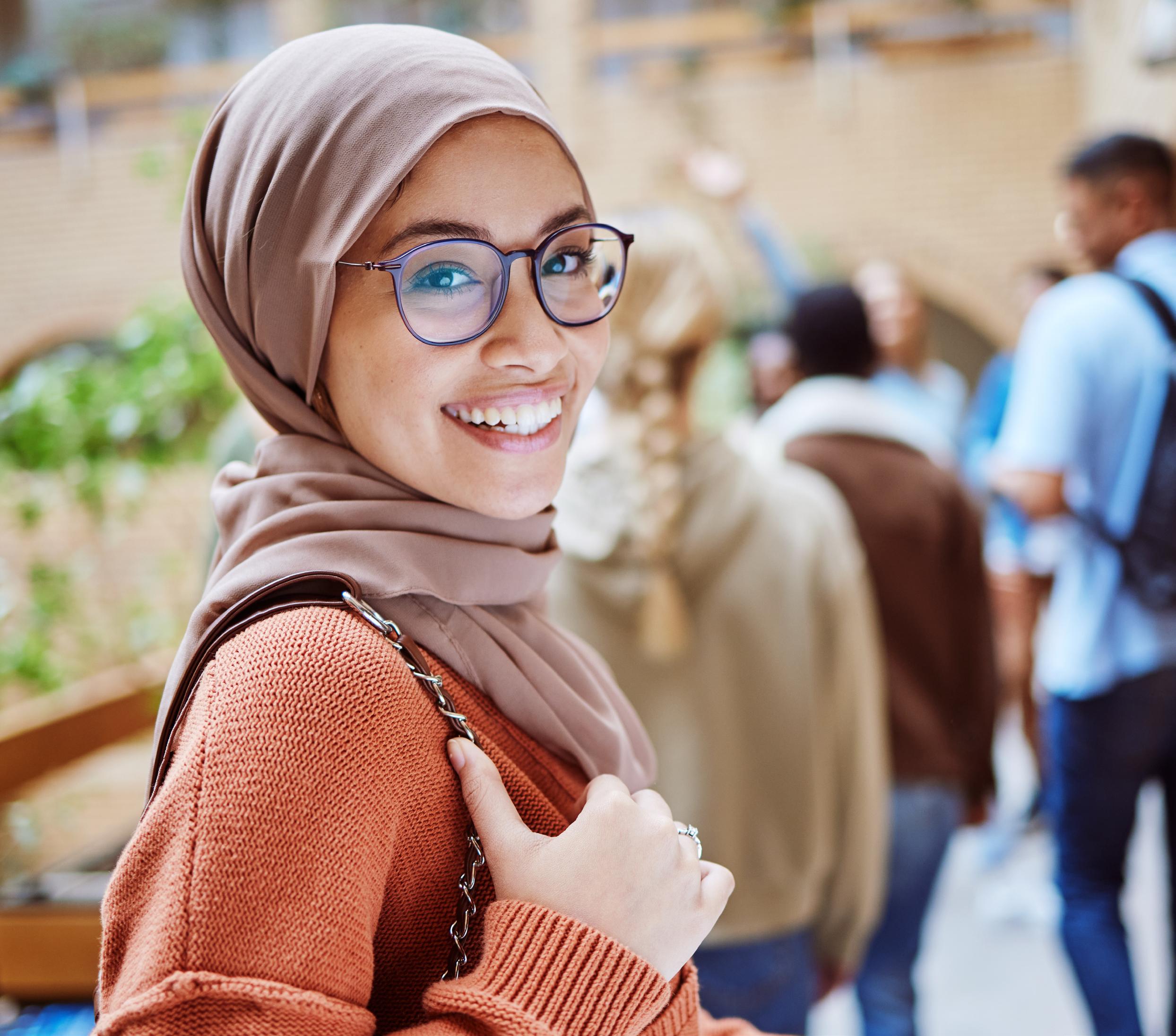IN ACTION
Pathways Research, Strategy, and Practice Brief

Elevating Neurodiversity in Community Colleges Opportunities for Increasing Inclusivity in Uncertain Times
Brett R. Nachman and Jason A. Keist University of Pittsburgh


ABOUT THE SERIES
The Equity in Action Research and Strategy Brief Series aims to explore and feature key issues, plans for action, and practices that advance and inclusion within P-20 education. These briefs seek to address persistent disparities in student opportunities and outcomes. By synthesizing current research, examining policy implications, and highlighting successful interventions, the series intends to provide educators, policymakers, and stakeholders with actionable insights to create more equitable learning environments. This series is designed to provide insights and guidance on developing, enhancing, and sustaining pathways that support students’ transitions across educational tiers. Strengthen partnerships among schools, colleges, employers, and community organizations to create cohesive, culturally responsive pathways for students.

* This brief series was supported by Gates Foundation under grant/ funding [grant number INV-001236]

Elevating Neurodiversity in Community Colleges: OpportunitiesforIncreasing InclusivityinUncertainTimes
Brett R. Nachman
Jason A. Keist
University of Pittsburgh
Introduction
For more than a century, American community colleges have served students from underrepresented communities, and disabled learners are no exception. Yet the extent to which neurodivergent individuals have been welcomed, let alone thrived, within such spaces remains in question. Though nearly 23% of community college students are disabled (NCES, 2023), existent literature shows how these colleges and institutional agents unfortunately perpetuate ableist norms (Hubrig, 2022; Mireles, 2022; Nachman, 2024). Ableism refers to preferring particular normative abilities and discriminating or devaluing those without such abilities (Wolbring, 2008). Many faculty remain unprepared to serve disabled students (Hansen & Dawson, 2020). Among the disabled students who must navigate community college are neurodivergent individuals,
including those with ADHD and autism, to name a few (Finkel, 2024). Despite neurodivergent students’ emergent prominence (Goodwin, 2025), we know little about what strategies or tactics colleges are deploying to meet neurodivergent students’ distinct strengths and needs.
Neurodiversity is valuable to embrace in the community college context; inherently these campuses’ missions prioritize supporting students’ diverse backgrounds – even if resource or capacity constraints result in falling short sometimes. Yet how can community colleges serve neurodivergent learners when there remains a lack of representation and conversation on the subject matter, particularly in a tenuous political landscape where disability as a form of diversity is devalued (Dunn, 2024)?
This research and strategy brief covers many angles to propel new directions for how community colleges can serve neurodivergent learners. First, it explores the roots of neurodiversity, the links between diversity, equity, inclusion, and belonging (DEIB) and how neurodiversity manifests in higher education, and the role of intersectional identities in this process. Later it presents recommendations to practitioners, researchers, and policymakers on how they can better support neurodiversity in community colleges.
What is Neurodiversity?
The term “neurodiversity” recognizes that there exists a wide variety of ways human cognition manifests across individuals. Diverse neurotypes play an integral role in the functioning of human societies similar to the function biodiversity plays within natural ecosystems (Dwyer, 2022). It can be said then that, as a species, humans are “neurodiverse.” Although, of import to the aims of this brief are those whose cognitive functioning deviates (or diverges) from what is considered to be the norm: those who are “neurodivergent.” Neurodivergent individuals are part of a broader, complicated umbrella of neurodiversity, a space that is ambiguous and very heterogenous in conditions, skills, and additional social identities, thus resulting in a multitude of neurodiversity approaches based on individuals’ paradigms and norms (Dwyer, 2022).
den Houting (2019) contends that proponents of the neurodiversity movement tend to align more with the social model of disability, which understands disability through the ways social structures have been built and maintained to adversely impact the lives of disabled people, whereas a medical model of disability places the onus of disabled people’s disparate life chances on innate medical deficits that may or may not be curable.
Neurodivergent conditions involve having distinct neurotypes in one’s brain, causing people to think and behave differently than the majority of people (Lange, 2022; Marble et al., 2024). Marble and colleagues define neurotypes as a “classification for a group of people whose brain functioning and associated traits are similar to each other” (2014, p. 12). Neurodivergent conditions can also include individuals whose brains are not only different from birth (e.g., autism, ADHD, dyscalculia), but also those whose brains change due to conditions like bipolar disorder or traumatic brain injuries (Marble et al., 2024). Given the various, negative connotations associated with these particular disabilities, people with them are often stigmatized, discriminated against, or harmed (Duncan et al., 2025; Marble et al., 2024). Yet “when we begin to recognize, accept, and respect these variations in human thinking as normal,
we begin to align with the concept of neurodiversity” (Marble et al., 2024, p. 11). More than ever, societies are seeing neurodivergent individuals’ differences as strengths or assets, as they can think through problems with distinct lenses, exhibit creativity, carry distinct skills, and foster more empathy, thus contributing to greater inclusivity (Marble et al., 2024).
What unites neurodiversity as a concept is the belief that neurological differences are beneficial. The neurodiversity movement, comprising both community members and their allies, faces challenges around identity and definition. Disagreements exist over who qualifies as neurodivergent, complicated by individuals with delayed diagnoses, those who reject labels, or who don’t identify with the broader community (Russell, 2020). Consequently, the neurodiversity movement, and people who are themselves neurodivergent , may lack a clear focus. However, when framed more loosely and with a strengthsbased mindset, we see a collection of neurodivergent individuals as providing beneficial, different perspectives and contributions. It is in this spirit that we urge higher education to embrace their inclusion and engagement.
Traditional Concepts of Diversity, Equity, Inclusion, and Belonging (DEIB)
The origins of diversity, equity, and inclusion (DEI) initiatives within higher education can broadly be traced to
American civil rights movements and accompanying federal legislation passed during the mid- to latetwentieth century. Momentum towards institutionalizing people’s inherent human dignity in the realms of labor, housing, and education began with the Civil Rights Act of 1964. Continued social justice efforts gradually extended legal protections to other historically oppressed groups with the passage of Title IX (1972) and the Americans with Disabilities Act (1990). Over time, advocates and practitioners have expanded the DEI conversation to include areas of belonging (Strayhorn, 2019) and accessibility (Timko, 2024). The American Civil Liberties Union differentiates between components of DEI and advances why each is uniquely important for addressing persistent barriers that have historically marginalized individuals and communities (Conway et al., 2025).
Ultimately, DEI initiatives aim to rectify inequities preemptively and proactively in student success outcomes for historically marginalized populations. These inequities often manifest in historically-situated systems that shape college policies, processes, and programs. Despite rhetoric that suggests DEI initiatives only support the target populations, more than fifty years of scholarly research in higher education has documented the benefits DEI initiatives create for all students who share space and learn from peers who occupy a multitude

Ultimately, DEI initiatives aim to rectify inequities preemptively and proactively in student success outcomes for historically marginalized populations.
of diverse backgrounds (Harper, 2025; Harper & Associates, 2024). DEI efforts also assist educators in developing the requisite skillsets and capacities to incorporate student-centered pedagogy and practices that challenge the status quo. Community colleges have instituted an array of initiatives and institutional change efforts to advance diversity, equity, and inclusion on their campuses, from training advisors to employ strategies affirming students’ religions to creating faculty/student or peer-to-peer mentoring programs for racially-minoritized students. Altogether, community colleges are well positioned to offer such programming based on their legacies of serving marginalized students across all backgrounds. Yet their efficacy may vary depending on institutions’priorities especially pertaining to professional development.
Intersectionality
To best understand neurodiversity, we must first appreciate the elements that contribute to many students’ multiply marginalized identities and how they overlap to create further layers of disenfranchisement. The term intersectionality was coined by Black feminist scholar Kimberlé Crenshaw (1989) as an analytic tool to expand the discourse of the times surrounding anti-discrimination law; to interrogate how laws meant to protect women and racially minoritized communities systematically overlooked the unique multi-axis experiences of Black women. While Black women existed at the
intersection of race and gender, their experiences were forced by courts to fit within a dichotomous either/or category. As Crenshaw recalls nearly 30 years after bringing intersectionality into the world lexicon:
Intersectionality, then, was my attempt to make feminism, anti-racist activism, and antidiscrimination law do what I thought they should — highlight the multiple avenues through which racial and gender oppression were experienced so that the problems would be easier to discuss and understand (Crenshaw, 2015).
Since its original inception for use in jurisprudence, intersectionality has broadened its reach and scope, influencing higher education scholars to consider how college structures interact with students’ intersectional identities to affect academic success outcomes, with particular attention paid to understanding students’ experiences through their voices (Brower et al., 2021; Castro & Cortez, 2017; Person et al., 2017; Solóranzo & Yosso, 2002; ZamaniGallaher & Bell, 2018).
Accordingly, many community college faculty, staff, and administrators have worked to understand the complexities of how intersections of race, gender, age, social class, ability, and sexual orientation impact how students navigate college and have sought to create requisite support structures
on their campuses using research and practice from the field to inform their efforts. The mission of Bristol Community College’s Women’s Center exemplifies an intersectional understanding of students’ lives, stating, “The Women’s center promotes the concept of intersectionality—that gender intersects with all other markers of identity—and thus works to help students understand the complexity of their lives and the lives of others” (para. 2).
While a large breadth of students’ intersectional identities is acknowledged in conversations and resultant studentfacing initiatives at the community college, there remains room for the inclusion of neurodivergence in discourse surrounding intersectionality. Importantly, Botha & Gillespie-Lynch (2022) remind us that the term neurodiversity was originally advanced as a new category within the matrix of intersectionality and that the term was meant to spur discussion leading to the emergence of a lager neurodivergent movement. Because the neurodivergent community is far from homogeneous, ensuring equitable representation of those within its ranks is critical. This involves the intentional consideration of neurodivergent student voices at the intersections of race, gender, sexual orientation, social class, age, and other pertinent demographic characteristics that impact the ways students experience the community college.
Neurodiversity in DEI
One of the many expectations community college educators are responsible for is ensuring students are participating in well-rounded educational experiences, including attending to students’ academic, emotional, vocational, and social development (Karp, 2016). A campus environment that successfully invests in the whole student produces benefits not only for individual students, but also for greater society as students apply knowledge and experiences to improve their daily lives. Making a concerted effort to explore and validate the experiences of neurodivergent students through a DEI lens creates a wider net within which to capture and honor the complexity of the entire student body. Furthermore, it is important to pay explicit attention to the experiences of minoritized neurodivergent collegians across race/ethnicity, sexual orientation, gender identity, and age. While incorporating neurodivergence within the DEI framework is a necessary step towards educational equity, doing so is not sufficient to adequately ameliorate inequities minoritized neurodivergent individuals face in education and employment outcomes. Substandard access to educational opportunities can compound existing social inequalities in employment outcomes, mental health, poverty, healthcare, and incarceration, especially for those who are racially minoritized (Sotire, 2025).
First, we must acknowledge that we may never have a clear picture of the number of neurodivergent students in higher education, or community colleges specifically, due to the need for students to self-report their disabilities (Newman et al., 2011). Some students avoid self-identifying as disabled for various reasons, including social stigma, acceptance, and safety (Hodges-Fulton & Monahan, 2025; Kennedy et al., 2025; Nachman, 2023a; Underhill et al., 2024).
Others remain undiagnosed or have received delayed diagnoses, thus further complicating who receives supports (e.g., Magnuson et al., 2024; Nayyar et al., 2025).
Creating a campus environment that is inclusive of diverse neurotypes could also create fertile campus conditions for increased rates of student selfdisclosure and resultant usage of disability services. Moreover, given that

an estimated 81% of autistic college students attend community college at some point in their academic careers (Shmulsky & Gobbo, 2019), the impact of incorporating neurodiversity within broader DEI initiatives holds significant promise of supporting autistic students in particular.
Neurodivergent students come to campus with distinct strengths, challenges, and perspectives developed while navigating a world constructed for their neurotypical peers. If colleges and universities are to proactively cultivate an inclusive campus environment that reflects the lived experiences of neurodivergent students, planning and implementation efforts must be responsive, creative, and span across areas of curriculum development, research, campus programming, advising, institutional research, and student support services. Accardo and colleagues (2024) reminds us that, “University accommodations designed to meet the preferences of those with brain-based differences could help students feel that their identities are being acknowledged and that their neurodivergent strengths are being recognized” (p. 12). Incorporating neurodiversity as an area of disability awareness and advocacy within DEI efforts would allow for a fuller understanding of student experiences and inform resultant transformations in how colleges operate to better
support neurodivergent students. For example, Park et al. (2024) recommend further development of research and practice related to neurodivergent adult students specifically such as transition programming/supports, training for adult educators to increase their acceptance of neurodivergent students, and fostering community within the classroom through building relationships with, and amongst, neurodivergent adult students. Incorporating neurodiversity within DEI would also help to educate neurotypical students on issues of neurodiversity similarly to how members of dominant social groups (e.g., students who identify as white, heterosexual, and male) become more informed about the experiences of minoritized groups through college-wide diversity initiatives (Critelli, 2023).
An intersectional perspective is critical when positioning neurodiversity within the broader DEI conversation. When discussing autism, we see that the experiences of women, transgender/ gender nonconforming, and racially minoritized autistics reveal nuances that should be recognized and reflected in relevant campus support services. Research informs us that women and
girls are underdiagnosed as autistic when compared to men and boys, adversely affecting their supportseeking behaviors, impacting social, educational, and workplace domains (Shmulsky & Gobbo, 2019). Similarly, even though autism is equally as prevalent across racial groups, autism diagnoses for Black children are not only less frequent than their white counterparts but also occur later in age (Gourdine, 2011). Racial inequities in rates and timing of autism diagnoses within the Black community might also help us to understand why autistic Black undergraduates have been found to be less likely than peers of other racial groups to identify with having a disability (Shattuck, et al., 2014). Some research suggests that there is a higher prevalence of autism within the transgender community. Mournet et al. (2024) found that one in four transgender/gender nonconforming (TGNC) adults meet the diagnostic criteria for autism. Of great concern, the authors found that rates of suicidality amongst TGNC and autistic college students was greater than found amongst cisgender and non-autistic participants. These findings underscore the importance of making accessible gender affirming mental health supports for TGNC and autistic students.
The aforementioned examples aid us in imagining an intersectional neurodivergence framework that could assist community college faculty and staff in developing innovative
practices regarding teaching and learning, advising, and programming that promote the strengths of neurodivergent students and the complexity of their identities.
Implications for Practice
Although neurodiversity-centered programming on community colleges is not widespread, nor well documented – with records often limited to event pages or news briefs on websites –existent offerings across postsecondary education more broadly may illuminate possibilities for translation in community colleges. Many institutions, among them Northern Virginia Community College, have supported the development of neurodiversity clubs which have been effective at fostering friendships and helping to create a more supportive culture for neurodiverse students (“Neurodiversity Club Meeting,” n.d.). As community colleges see the emergence of neurodivergent students, many of whom may seek an outlet for connection, faculty and staff who are similarly neurodivergent may consider serving as advisors of such clubs. These relationships can bolster not only connectivity across campus figures but also help ensure neurodivergent students have key allies. Similarly, community colleges can assemble affinity groups among neurodivergent faculty and staff to foster community and create ideas for new professional development offerings on campus. In tandem, developing a social network amongst neurodivergent faculty and

staff could also promote professional peer support efforts to combat barriers and challenges within higher education faced by some college practitioners who self-identify as neurodivergent (Mellifont, 2023).
More broadly, the implementation/ establishment of Disability Cultural Centers (DCCs) exemplifies wider initiatives that illustrate institutional investment in programming that supports all disabled students, and among them neurodivergent learners.
Among the 18 DCCs in existence as of late 2024, only one - Santa Rosa Junior College - is based at a community college (“List of DCCs,” 2024). With programming and resources such as disability movie screenings, meditation sessions, books, fidget tools, study spaces, and more, DCCs like the one at Santa Rosa Junior College cultivate campuses that afford comfort, community, and shared learning (“Our space,” n.d.). These endeavors are neither labor intensive nor financially
overwhelming; they can happen with some administrative support, passionate and knowledgeable staff, and existent resources.
Campus events can similarly drive community building among neurodivergent individuals. Through Austin Community College District’s NeuroBats of ACCess Autism student organization, team members assembled a series of programs, including meditation sessions and crafts, for the entire campus community (“ACC celebrates,” n.d.). Meanwhile, Neurodiversity Celebration Weeks, like the one offered at Community College of Baltimore County, with panels, conversations, and workshops to educate the wider campus, promote neurodiversity acceptance (“Neurodiversity Celebration Week,” n.d.). By intentionally engaging campus constituents who possess neurodiversity expertise and who can bring unique skills to share with others (e.g., meditation), community
colleges can craft these events with minimal time and fiscal expenses, yet the payoff can be tremendous for illustrating a firm stance on the value of neurodiversity. That said, it is important to bolster celebratory weeks with authentic and sustained supports and services so such efforts don’t appear performative to neurodivergent communities. Community colleges must draw on these weeklong or monthlong celebrations as springboards for more sustained programming led by faculty, staff, and students who are rewarded for their labor as a form of institutional service.
Programming can also manifest consistently through annual events and courses. Scholars have called for the addition of orientation sessions that are specifically targeted for neurodivergent students and their families to reduce anxiety and provide awareness of intentional supports they can tap (Shmulsky et al., 2015) or even providing distinct modalities of engagement to align with student comfort (Nachman, 2023b). Yet there remains little evidence of such programming offered. Neurodiversity-affirming content extends to faculty investing in engaging in professional development around principles like Universal Design for Learning and who compassionately guide neurodivergent students in their pedagogical practices (Hamilton & Petty, 2023). Employing Universal Design principles can extend beyond the classroom and across the community college writ large; creating quiet zones
in the workplace can reduce stress and aid comfort (Twumasi & Burton, 2024).
Longer-lasting offerings for neurodivergent individuals often come in the form of formalized offices, spaces, or programming. The advent of autismspecific college support programs, with more than 115 in existence as of 2023 - and 18 situated in two-year colleges, as of July 2025 (“Autism-specific college support programs,” 2025) - has been tracked by the College Autism Network as a means of cataloguing spaces with specialized services for autistic people (Blake, 2023). Settings like these, among others on campuses, offer sensory rooms that feature decompression tools like noise-canceling headphones, heavy blankets, beanbags, swings, and other comforts (Weintraub, 2020). Adding such campus spaces promote a sense of affirming neurodivergent students’ needs for feeling comfort and safety, though the fiscal and space constraints might challenge the feasibility of fiscally supporting such programming. While there might be constraints about the difficulty of establishing dedicated spaces with resources, all campuses should, at the very least, collaborate with disabled students to support the creation of informal spaces for neurodivergent individuals to gather and build community.
Implications for Research
Research on neurodiversity in higher education is an emerging field, with scholars generating recommendations
for campus leaders to create more inclusive spaces (Dwyer et al, 2023). However, this work, while valuable, largely treats higher education as monolithic rather than examining differences across institutional types. Community college students require distinct considerations, and to date, our understandings of neurodivergent community college student experiences are limited to a smattering of pieces examining disabilities like autism (e.g., Nachman et al., 2025; Shmulsky & Gobbo, 2019) and ADHD (Flowers, 2012; Kuriyan et al., 2013). In conducting studies on neurodiversity within the community college context, researchers must entertain the particularities of neurodivergent learners within these spaces. Importantly, it is imperative that colleges develop the institutional capacity to disaggregate and analyze data at the institutional level. Doing so will allow practitioners to more accurately understand the extent to which neurodivergent learners are present on their campuses as well as aid colleges in building responsive systems and processes to support these learners as they navigate their multifaceted lives. For instance, community colleges, which enroll a notable proportion of student parents (Dundar, 2024), may have a portion of those learners who are themselves also neurodivergent. What additional hurdles may these students face in handling executive functioning issues tethered with their disability, alongside managing their coursework and raising their children?
To what extent does tracking bus schedules influence how neurodivergent students plan their days? After all, many community college students often rely on variable public transportation to access their education (SmithOnyewu et al., 2025). These are among the questions that further impact neurodivergent community college students’ experiences that we call on scholars to explore at a more national level, as well as encourage institutional researchers to implement more locally.
Implications for Policy
Academia continues to exist in a state of uncertainty and must consistently and creatively adapt to pressures from federal and state policymakers as these entities enact broadening administrative oversight and influence. Nonetheless, community colleges are often at the epicenter of embracing their diverse student communities through policies and measures. Notably, in Illinois, the state’s House of Representatives passed House Resolution 219 (include link and citation) in 2023 which encourages higher education institutions to embrace the neurodiversity paradigm and adopt a statement of inclusivity. This policy resulted in Oakton College advancing a Neurodiversity Inclusion Statement in 2023 that was voted on by its Board of Trustees (“Oakton adopts,” 2023). Statements like these show an institutional commitment to supporting its neurodiverse community and this example illustrates how state policy can advance institutional policy. Community
college systems must continue to strengthen ties with state legislators and their staffs to educate them on the scale and complexity of neurodiverse students in higher education and the imperative to provide supports for neurodiverse student success.
Encouragingly, Illinois is not the only state demonstrating its commitment toward neurodiversity. New Jersey state Senator Andrew Zwicker, in January 2025, put forward a legislative package to support neurodiversity policies across several sectors, including education and employment (Bergeron, 2025). One of the bills - the Tech Talent Pipeline - offers the idea of developing an Accessibility Coordinator Pilot Program that would hire staff at three college campuses to support neurodivergent students via advising and connecting with employers, as well as instituting statewide faculty and staff training (Bergeron, 2025).
While the broader landscape of neurodiversity-affirming policies and statewide initiatives remains in question, these examples show the possibilities of leaning into measures that promote acceptance and address inequities. Community colleges can drive an emergent and more capable workforce should statewide policies embrace - and invest in - neurodiversity professional development.
Conclusion
Much like the students who flow into and out of these dynamic institutions, community colleges have a wide range of capabilities and are striving to effectively serve their learners. Neurodiversity is no longer hidden in the shadows yet concurrently it is obscured by misunderstandings, stereotypes, and problematic narratives. As illustrated here, community colleges are ripe spaces for elevating these students’ experiences in ways that are welcoming, not pejorative. Ultimately, the opportunities for instigating lasting and meaningful change are contingent upon the combination of policymakers and practitioners centering neurodivergent voices, leveraging their strengths, and valuing their opinions- as a collective and across their intersections of identities.
Accardo, A. L., Bomgardner, E. M., Rubinstein, M. B., & Woodruff, J. (2024). Valuing neurodiversity on campus: Perspectives and priorities of neurodivergent students, faculty, and professional staff. Journal of Diversity in Higher Education. Advanced online publication.
ACC celebrates Autism Acceptance Month with events & student-centered support. (2025, April 16). ACC Student InfoHub. Retrieved from https://students.austincc.edu/infohub/2025/04/16/ acc-celebrates-autism-acceptance-month-with-events-student-centered-support/
“Autism-specific college support programs (ASPs)” (2025). College Autism Network. Retrieved from can.softr.app
Bergerson, T. (2025, January 31). Neurodiversity now: Zwicker unveils comprehensive legislation that would make state leader in serving community. Return on Investment New Jersey Retrieved from https://www.roi-nj.com/2025/01/31/politics/neurodiversity-now-zwicker-unveilscomprehensive-legislation-that-would-make-state-leader-in-serving-community/
Blake, J. (2023, December 14). Creating career pathways for neurodiverse students. Inside Higher Ed. Retrieved from https://www.insidehighered.com/news/diversity/disability/2023/12/14/ creating-career-pathways-neurodiverse-students
Botha, M., & Gillespie-Lynch, K. (2022). Come as you are: Examining autistic identity development and the neurodiversity movement through an intersectional lens. Human Development, 66(2), 93-112.
Bristol Community College (n.d.). Women’s Center. Retrieved from https://bristolcc.edu/ studentservices/resources/womenscenter/
Brower, R. L., Jones, T. B., & Hu, S. (2021). Overcoming the “trash talk in your head”: Extending an ethic of care to students experiencing intersectional stigma in community college. AERA Open, 7(1), 1-12. DOI: 10.1177/23328584211006381
Castro, E. L., & Cortez, E. (2017) Exploring the lived experiences and intersectionalities of Mexican community college transfer students: Qualitative insights toward expanding a transfer receptive culture. Community College Journal of Research and Practice, 41(2), 77-92, DOI: 10.1080/10668926.2016.1158672
Conway, K., Zeng, K., & Mimbela, R. (February 2025). DEI and Accessibility, Explained American Civil Liberties Union. Retrieved from https://www.aclu.org/news/racial justice/dei-andaccessibility-explained
Crenshaw, K. (1989). Demarginalizing the intersection of race and sex: A Black feminist critique of antidiscrimination doctrine, feminist theory and antiracist politics. University of Chicago Legal Forum, 1989(1), 139.
Crenshaw, K. (2015, September 24). Why intersectionality can’t wait. The Washington Post Retrieved from https://www.washingtonpost.com/news/in-theory/wp/2015/09/24/whyintersectionality-cant-wait/
Creaven, A. M. (2025). Considering the sensory and social needs of disabled students in higher education: A call to return to the roots of universal design. Policy Futures in Education, 23(1), 259-266.
Critelli, T. (2023). Diversity: 5 Ways it Boosts Student Success. Retrieved from https://www.stjohns. edu/news-media/johnnies-blog/diversity-5-ways-it-boosts-student-success den Houting, J. (2019). Neurodiversity: An insider’s perspective. Autism, 23(2), 271-273. Duncan, P., & Strong, Z. (2025). Laughing with me, not at me: The importance of challenging stereotypes and misconceptions in mental health and neurodivergence. Journal of Disability & Religion, 29(2), 157-170.
Dundar, A. (2024, October 10). New data insights on student parents from multi-organizational collaborative effort. Institute for Women’s Policy Research https://iwpr.org/new-data-insightson-student-parents-from-a-multi-organization-collaborative-effort/
Dunn, D. S. (2024, September 1). Disability as a DEI concern in teaching. American Psychological Association https://www.apa.org/ed/precollege/psychology-teacher-network/introductorypsychology/disability-as-dei
Dwyer, P. (2022). The neurodiversity approach (es): What are they and what do they mean for researchers? Human Development, 66(2), 73-92.
Dwyer, P., Mineo, E., Mifsud, K., Lindholm, C., Gurba, A., & Waisman, T. C. (2023). Building neurodiversity-inclusive postsecondary campuses: Recommendations for leaders in higher education. Autism in Adulthood, 5(1), 1-14.
Finkel, E. (2024, March 26). Embracing neurodiversity on campus. Community College Daily https://www.ccdaily.com/2024/03/embracing-neurodiversity-on-campus/ Flowers, L. (2012). Navigating and accessing higher education: the experiences of community college students with attention deficit hyperactivity disorder (Doctoral dissertation, University of Southern California).
Gillespie-Lynch, K.; Bublitz, D.; Donachie, A.; Wong, V.; Brooks, P. J.; & D’Onofrio, J. (2017). “For a long time our voices have been hushed”: Using student perspectives to develop supports for neurodiverse college students. Frontiers in Psychology, 8(544). doi: 10.3389/fpsyg.2017.00544 Goodwin, J. (2025, March 13). New Majority Learner data stories: neurodivergent students. Genio Gourdine, R. M.; Baffour, T. D.; & Teasley, M. (2011). Autism and the African American community. Social Work in Public Health, 26, 454-470. DOI: 10.1080/19371918.2011.579499
Hamilton, L. G., & Petty, S. (2023). Compassionate pedagogy for neurodiversity in higher education: A conceptual analysis. Frontiers in Psychology, 14, 1093290.
Hansen, K. D., & Dawson, D. L. (2020). “We can do better”: Community college faculty preparedness for teaching students with learning disabilities. Journal of Diversity in Higher Education, 13(4), 309.
Harper, S. (2025). Leveraging Research and Demanding Proof in Responsive to Legislative Attacks on DEI in U.S. Higher Education. AERA Open, 11(1), 1-7.
Harper, S., & Associates. (2024). Truths about DEI on college campuses: Evidence-based expert responses to politicized mis-information. University of Southern California Race and Equity Center.
Hodges-Fulton, M. R., & Monahan, J. (2025). Understanding autistic identity disclosure in higher education. Autism in Adulthood. Advanced online publication.
Hubrig, A. A. (2022). Symposium: Cultivating anti-ableist action across two-year college contexts. Teaching English in the Two-Year College, 49(3), 257-272.
Karp, M. M. (2016). A Holistic conception of nonacademic support: How four mechanisms combine to encourage positive student outcomes in the community college. New Directions for Community Colleges, 2016(175), 33-44.
Kennedy, L. J., Richdale, A. L., & Lawson, L. P. (2025). Comparing disclosure and supports used by higher-education students with neurodivergent or mental health conditions. Autism in Adulthood. Advanced online publication.
Kuriyan, A. B., Pelham, W. E., Molina, B. S., Waschbusch, D. A., Gnagy, E. M., Sibley, M. H., Babinski, D. E., Walther, C., Cheong, J., Yu, J., & Kent, K. M. (2013). Young adult educational and vocational outcomes of children diagnosed with ADHD. Journal of Abnormal Child Psychology, 41, 27-41.
Lange, S. (2022). Different not less: Neurodiversity as a lens for understanding our students better. Scope: Contemporary Research Topics (Learning and Teaching), 11, 113–119. https://doi. org/10.34074/scop.4011005
List of DCCs. (2024, October 14). University of Illinois Chicago. Retrieved from https://dcc.uic.edu/ symposium/list-of-dccs/
Magnuson, L. Opdahl, J., Nataraj, L., & Olivas, A. P. (2024). Different, not deficient: Supporting university and college students with ADHD in academic libraries. The Library Quarterly, 94(3), 219-237.
Marble, J., Chabria, K., & Jayaraman, R. (2024). Neurodiversity for dummies. John Wiley & Sons. Mellifont, D. (2023). Ableist ivory towers: A narrative review informing about the livedexperiences of neurodivergent staff in contemporary higher education. Disability & Society, 38(5), 865–886. https://doi.org/10.1080/ 09687599.2021.1965547
Mireles, D. (2022). Theorizing racist ableism in higher education. Teachers College Record, 124(7), 17-50.
Mournet, A. M.; Kellerman, J. K.; Garner, R. C.; Kleiman, E. M. (2024). Suicidal thoughts and behaviors among autistic transgender or gender-nonconforming US college students. JAMA Network Open, 7(10), 1-10. doi:10.1001/jamanetworkopen.2024.38345
Nachman, B. R. (2023a). “It’s like you’re a jockey riding a horse and you’re in a world of centaurs”: Unmasking autistic college students’ identity development. Journal of College Student Development, 64(4), 407-422.
Nachman, B. R. (2023b). “The beacon on campus”: How an autism-specific community college support program addresses ableism and autism acceptance. College Student Affairs Journal, 41(1), 31-45.
Nachman, B. R. (2024). The many dimensions of academic ableism: Career and technical education (CTE) faculty attitudes in engaging with disabled community college students. The Review of Higher Education. Advanced online publication.
Nachman, B. R., Cox, B. E., Gillespie-Lynch, K., Lounds Taylor, J., Gelbar, N. W., & Raclaw, E. (2025). “Enjoy your time and be confident”: Honoring autistic community college students’ multifaceted interpretations of success. Journal of Diversity in Higher Education. Advanced online publication.
Nayyar, J. M., Stapleton, A. V., Guerin, S., & O’Connor, C. (2025). Exploring lived experiences of receiving a diagnosis of autism in adulthood: A systematic review. Autism in Adulthood, 7(1), 1-12.
NCES (2023). 2019-20 National Postsecondary Student Aid Study (NPSAS:20) [AACC analysis]
Neurodiversity Celebration Week (n.d.). Community College of Baltimore County. Retrieved from https://www.ccbcmd.edu/About/Events/2025/03/Neurodiversity-Celebration-Week.html
Neurodiversity Club Meeting (n.d.). Northern Virginia Community College. Retrieved from https:// calendar.nvcc.edu/event/neurodiversity_club_meeting
Newman, L., Wagner, M., Knokey, A. M., Marder, C., Nagle, K., Shaver, D., & Wei, X. (2011). The post-high school outcomes of young adults with disabilities up to 8 years after high school: A report from the National Longitudinal Transition Study-2 (NLTS2). NCSER 2011-3005. National Center for Special Education Research Oakton adopts Neurodiversity Inclusion Statement. (2023, August 16). Oakton College. Retrieved from https://www.oakton.edu/about/news/2023/08/oakton-adopts-neurodiversity-inclusionstatement.php
“Our space.” (n.d.). Santa Rosa Junior College. Retrieved fromhttps://drd.santarosa.edu/our-space
Park, T. W., Szabo, J., Sheward, K., & Rogers-Shaw, C. (2024). Does neurodiversity have a place in adult education’s discussion of diversity and social justice?
Person, D., Dawson, R., Garcia, Y., & Jones, A. (2017). The intersectionality of gender and race— Programs to support men of color in education. Constructions of Gender, 2017(179), 67-76.
Russell, G. (2020). Critiques of the neurodiversity movement. In S. Kapp (ed.), Autistic community and the neurodiversity movement: Stories from the frontline (pp. 287-303). Palgrave Macmillan.
Shattuck, P. T., Steinberg, J., Yu, J., Wei, X., Cooper, B. P., Newman, L., Roux, A. M. (2014). Disability identification and self-efficacy among college students on the autism spectrum. Autism Research and Treatment, 2014, 1-7. http://dx.doi.org/10.1155/2014/924182
Shmulsky, S., Gobbo, K., & Donahue, A. (2015). Groundwork for success: A college transition program for students with ASD. Journal of Postsecondary Education and Disability, 28(2), 23524
Shmulsky, S., & Gobbo, K. (2019). Autism support in a community college setting: Ideas from intersectionality. Community College Journal of Research and Practice, 43(9), 648-652.
Singer, J. (2016). Neurodiversity: The birth of an idea. Self-published.
Smith-Onyewu, Z., Stein, M. L., Cortes, J. B., Kim-Christian, P., & Dewey, N. (2025). Public transit and urban community college access. Research in Higher Education, 66(1), 1-29.
Sotire, T. (2025). Race and neurodiversity: Understanding intersectionality and privilege–My story. In Y. Ade-Serrano & O. Nkansa-Dwamena (Eds.), Reimagining race in psychology (pp 221-236). Routledge.
Solóranzo, D. G. & Yosso, T. J. (2002). Critical Race Methodology: Counter-storytelling as an analytical framework for education research. Qualitative Inquiry, 8(1), 23-44
Strayhorn, T. L. (2019). College students’ sense of belonging: A key to educational success for all students (2nd ed.). Routledge.
Timko, M. L. (2024). Universal Design and DEI. Legal Reference Services Quarterly,43(1–2), 1–21. https://doi.org/10.1080/0270319X.2024.2334506
Twumasi, R., & Burton, L. (2024). From Margins to Mainstream: Embracing Neurodiverse Needs for an Inclusive Workplace. Ought: The Journal of Autistic Culture, 66-93.
Underhill, J. C., Clark, J., Hansen, R. S., & Adams, H. (2024). Exploring autistic college students’ perceptions and management of peer stigma: An interpretative phenomenological analysis. Journal of Autism and Developmental Disorders, 54, 1130–1142. https://doi.org/10.1007/ s10803-022-05867-7
Weintraub, K. (2020, February 2). US colleges offering sensory rooms to students with anxiety, autism, and ADHD. The Independent. Retrieved from https://www.independent.co.uk/news/ world/americas/college-sensory-room-anxiety-autism-adhd-ptsd-student-a9313311.html
Wolbring, G. (2008). The politics of ableism. Development, 51(2), 252-258.
Zamani-Gallaher, E. M., & Bell, A. A. (2018, Fall). Identity, intersections, and students with disabilities in community colleges. Office of Community College Research and Leadership.

*The views and opinions expressed in this brief are those of the author(s) and do not necessarily reflect the official position of the funding organization.
Suggested Citation:
Nachman, B. R. & Keist, J. A. (2025, Fall). Elevating Neurodiversity in Community Colleges: Opportunities for Increasing Inclusivity in Uncertain Times. In E. M. Zamani-Gallaher (Ed.), Equity in Action. University of Pittsburgh School of Education, Community College Research, Praxis, and Leadership (CCRPL).

